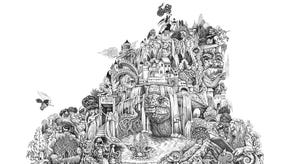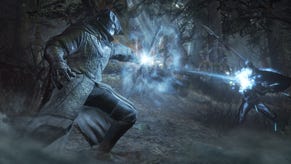Dark Souls 3 - The basics and the best farming spots
Everything you need to know, from class selection to combat and consumables, loot, levelling and the best places in the game to farm souls.
From a distance, Dark Souls looks like any third-person action RPG, and while it shares many of the mechanics with other titles in the genre it also does things a little differently. If you're new to the series it can all seem a bit baffling, so here's a grounding for those of you who don't know your Ashes from your Estus Flasks. Further down you'll find a guide to levelling your character efficiently, including where to find the best places in the game to farm Souls.
- You can find the rest of our Dark Souls 3 guide on the main guide page.
Remember: in Dark Souls dying is pretty much a central game mechanic, and to start with you're likely to die a lot. If you find you can't go more than five minutes without meeting a sticky end - don't worry, this is normal, and as you learn how each enemy type behaves, where they're lurking, and how to tackle them, you'll start dying less often. (At least for a while.)
When picking a starting class: It's possible to build any kind of character, regardless of your choice of starting class. But if you're new to Dark Souls, we'd recommend building a hybrid of damage dealer and tank using the Knight as a starting point. The Knight's initial armour is a reasonable balance between agility and protection; you start with a ring that grants bonus health; and the pre-rolled stats provide a good base for a melee-focussed combat style. By all means experiment and find a style that suits you, but most beginners do find combat easier to handle with a melee weapon and shield equipped most of the time, and a fairly durable character.
Estus Flasks, Bonfires and Embers
Consuming Estus is really the only way in the game to heal or regain FP (mana), and while the supply is effectively infinite, there's a limit to how much you can carry at any one time, and your flask can only be refilled at a bonfire. It's also a single pool for both HP and FP, so choosing between a ready supply of healing or magic power can be a balancing act. The blacksmith in the hub can change how much of your Estus supply is allocated to each.
Bonfires act as healing and restocking stations, checkpoints, safe havens, and fast travel points, and finding one is generally accompanied by a huge sigh of relief. Resting at one will refill your Estus Flask, but doing so also respawns all enemies (with the exception of bosses and giants), so backtracking to top your supplies up isn't really an option.
Thankfully, the size of your flask can be increased by finding Estus Shards over the course of your travels, and the power of each dose can be increased by finding Undead Bone Shards (these upgrades can only be performed in the hub area), so leave no stone unturned. Alternatively, you can cheat and take a look at our Dark Souls 3 Bone Shard Location guide and Dark Souls 3 Estus Shard Location guide.
By consuming an Ember you're granted an additional 30% HP, can summon spirits to help with some boss fights, and will be able to invade (and be invaded by) other players. These effects last until you die, and as Embers are a fairly scarce commodity they're best saved for those moments where you're really starting to struggle.
Combat, weapons, armour and enemy types
Odd though it may seem, combat in the Souls games is one of the most realistic depictions of real-life violence you'll ever find: one or two blows can prove fatal, blocking requires effort and you can still be knocked over or injured anyway, fighting with heavy pieces of metal is tiring, and on the whole it's a lot better to just avoid getting hit in the first place if you can.
Generally speaking, you're much better taking your time in each fight: waiting for openings in your opponent's defence before striking not only reduces the chance of you taking damage, it also tends to result in your own attacks being more effective. Blocking, evasion, and mastery of the dodge-roll are vital - you may be able to survive a few fights by simply running in and tanking damage while waving a sword about haphazardly, but as a long-term survival strategy, it's unlikely to prove effective.
Weapons: Different weapons attack in different ways: light weapons tend to do less damage than heavier ones but require less stamina to use and can attack faster, long bladed weapons are good in open areas against multiple opponents but may be unusable in confined spaces, thrusting weapons can be more effective than slashing against slow enemies, and so on, so keeping more than one on you is generally a good idea. They can be reinforced and upgraded at the blacksmith in the hub area by using Titanite and gems that you'll collect along the way, so remember to pay him a visit whenever you're levelling up.
Armour and Mobility: Armour and weapon weight affect your mobility and stamina usage, so a balance needs to be kept between protection from damage and the ability to get out of the way - light armour will keep you nimble but will help less if you get hit, whereas heavy armour will make you less manoeuvrable but provide better protection against damage and make you harder to stagger. Keep an eye on your Equip Load stat when you try out new gear: at 70%, your ability to roll will be reduced, and when it hits 100% you'll be almost unable to move.
Enemy types: Enemies come in a wide range of shapes and sizes, but broadly speaking skinny or spindly-limbed enemies rely on speed, and more muscular enemies will rely on brute strength. Heavy enemies can still have a quick attack or two, and skinny ones can still pack a huge punch, but their general attack style and behaviour will be governed by their body shapes.
In addition to physical damage, some enemies will apply status effects - an icon and a meter will appear in the centre of your HUD, and when the meter fills you'll be hit by the effect, so they're often an indication to back away from combat for a moment to let them drop. Effects include frostbite (slows movement), toxicity (gradual HP loss until it clears), bleeding (large, sudden HP loss), and curse (instant death).
(Bosses are an exception to this, of course, but we won't spoil any of the fun by going into them in any detail here.)
Loot and Souls
Depending on your Luck stat, enemies will occasionally drop some loot when they die. Usually it's just a few extra souls or a junk weapon that you can sell, but sometimes it's more interesting.
You'll also find items on the hundreds of corpses that litter the place, and these are usually more substantial. As a general rule, the harder it is to get to one of them, the more valuable it's likely to be: corpses out in the open will usually hold a small number of trapped souls or some Titanite; ones that are a little tricky to get to will likely contain an Ember or a larger trapped soul; and those that you have to go a long way out of your way or face great danger to collect will range from rings to Estus and Undead Bone Shards.
Not quite last but definitely not least are the Souls after which the games are named. They come in three types - soft souls, trapped souls, and named souls - and act as both XP and currency for use at vendors.
Trapped and named souls are collected as items and you keep hold of them if you get killed. Soft souls are collected automatically from nearby enemies when they die (either at your hand or someone else's), but get dropped when you die. If you can return to where you dropped them without dying again you can collect them, but if you die again before you can reclaim them, they're gone forever - so it's never wise to carry too many around.
Consuming trapped and named souls converts them into soft souls, which is required before you can use them, but until you need them it's best to keep them safe in your inventory.
Named Souls are dropped by bosses, and aside from their large soul value they have an additional use: in the hub area, sat on a throne, you'll find Ludleth of Courland, and once you've given him the Transposing Kiln he'll swap specific named souls for unique weapons or other items.
Farming
There are a few points in the game where there are either a large number of enemies or one high-value opponent placed near to a bonfire, and you can kill the bad guys and rest at the bonfire to force them to respawn as often as you like. So if you're ever feeling overwhelmed by the odds, you may want to make a few laps of these areas to stock up on souls with which to level up your character and buy gear.
Cathedral of Ash: It takes about a minute to run a circular route round the area, and each lap will net you 220 souls.
Dilapidated Bridge: This is worth around 600 souls per minute. Run from the bonfire towards the heavy under the arch, kill him, and return. Each lap takes about 30 seconds - and as a bonus, he seems more prone to item drops.
Cleansing Chapel: You can gather 900 or so per minute by running out through the front door and quickly dealing with the enemies just to the right.
Farron Keep Outskirts: This one's a little different - the actual soul rate is out of your control here, as someone else is doing all the work, but as it requires just running and then standing still for a while, you can read a book or something while you're doing it. Just head from the bonfire to the archway into the outer area to trigger two enemies into making a patrol, step back a little to stay out of sight, and wait.
Profaned Capital: 2,500 souls per minute available here. From the bonfire, drop down the ladder into the centre of the tower, drop through the opening at the back, run round anti-clockwise and tackle the flying statue, then climb up the ladder back into the tower. If you position yourself just in front of the ladder lying on the ground outside as he flies in, he'll land in a perfect position for you to strike the first blow, and it does actually save a few seconds to throw yourself off the edge and die afterwards (as long as you remember to collect your souls each time).
How beneficial these farming runs are depends largely on your current level - to go from 16 to 17 requires 1882 souls, but to go from 71 to 72 takes a little over 30,000 - and it's not a realistic strategy for making massive gains. But if you're a few souls short of levelling up, it's handy to have a ready source.
Levelling and buying items
Your soul pool is used for both improving your own stats and buying gear and upgrades, so you need to balance one with the other, but the lion's share of your souls will likely be used for levelling purposes.
There are a lot of stats you can increase when you gain a new level, and each one will affect a range of secondary characteristics: for example, Strength will increase both your melee attack power and damage resistance. Before you're committed to an upgrade, the UI will highlight all the areas it improves so you know what you're going to get. (All the stat items can be increased to 99, so the level cap is around 800.)
Where you concentrate your improvements depends on your style of play and your preferred armour and weapon loadout. But if you're taking the melee damage/tank route, then Vigor, Endurance, Strength and Vitality are the most important.
Finding your way around
The first section of the game is quite straightforward navigation-wise, but once you get properly stuck in you will discover that the paths split and it can be quite tricky to identify where you should head to next. We have prepared a detailed overview in our Dark Souls 3 - where to go guide, which includes a handy map indicating how the different locations connect to each other.
- Keep reading for our guide to joining every Covenant in Dark Souls 3.
- You can find the rest of our Dark Souls 3 guide from the first page of this article.








